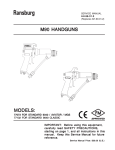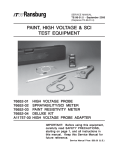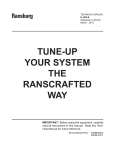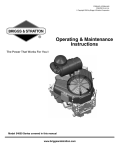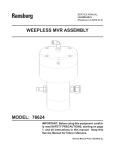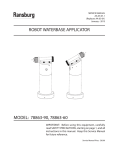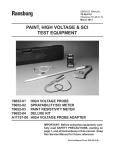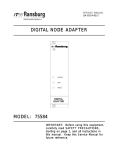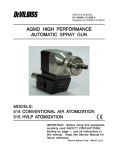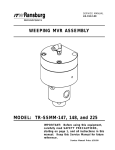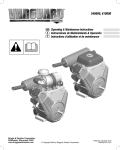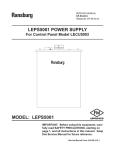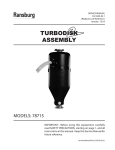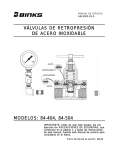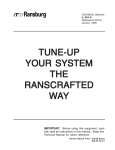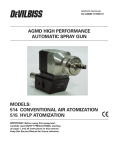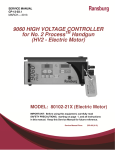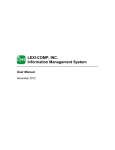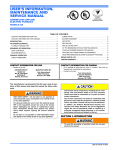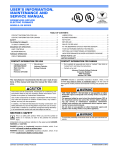Download 9040 CLASSIC HIGH VOL 9040 CLASSIC HIGH
Transcript
SERVICE MANUAL CP-97-03.6 (Supercedes CP-97-03.5) 9040 CLASSIC HIGH VOL TAGE POWER SUPPL Y VOLT SUPPLY for the No. 2 ProcessTM Handgun MODELS: 76657-14 76657-142 NO.2 HANDGUN, ELECTRIC MOTOR, DOMESTIC VERSION NO.2 HANDGUN, ELECTRIC MOTOR, EXPORT VERSION IMPOR TANT IMPORT ANT:: Before using this equipment, carefully read SAFETY PRECAUTIONS, starting on page 1, and all instructions in this manual. Keep this Service Manual for future reference. Service Manual Price: $30.00 (U.S.) N O T E : This manual has been changed from revision CP-97-03.5 to revision CP-97-03.6 CP-97-03.6. Reasons for this change are noted under “Manual Change Summary” inside the back cover of this manual. 9040 Classic for the No. 2 Process Handgun - Contents CONTENTS SAFETY: PAGE 1-5 SAFETY PRECAUTIONS......................................................... 1 HAZARDS / SAFEGUARDS..................................................... 2 INTRODUCTION: 6-7 GENERAL DESCRIPTION....................................................... 6 SPECIFICATIONS..................................................................... 7 INSTALLATION: 8-10 LOCATION................................................................................. 8 INPUT VOLTAGE SELECTION................................................ 8 INPUT CONNECTIONS............................................................ 9 EXTERNAL CONNECTIONS................................................... 9 OPERATION: 11-12 THEORY OF OPERATION....................................................... 11 OPERATING PROCEDURES.................................................. 12 MAINTENANCE: 13-23 ROUTINE PREVENTIVE MAINTENANCE..............................13 TROUBLESHOOTING..............................................................13 TROUBLESHOOTING GUIDE.................................................17 9040 CLASSIC NO.2 POWER SUPPLY BLOCK DIAGRAM..19 SERVICE LEVEL.......................................................................20 REPLACEMENT PROCEDURES............................................ 20 PARTS IDENTIFICATION: 24-27 9040 CLASSIC NO.2 POWER SUPPLY / PARTS LIST.......... 24 RECOMMENDED SPARE PARTS LIST.................................. 26 ACCESSORY PARTS LIST...................................................... 26 WARRANTY POLICIES: 28 LIMITED WARRANTY............................................................... 28 APPENDIX: 29-33 PAINT AND SOLVENT SPECIFICATIONS............................. 29 VISCOSITY CONVERSION CHART........................................30 VOLUMETRIC CONTENT OF HOSE OR TUBE.....................32 KV OUTPUT TEST & GROUND TEST LOG........................... 33 CP-97-03.6 CP-97-03.6 9040 Classic for the No. 2 Process Handgun - Safety SAFETY SAFETY PRECAUTIONS Before operating, maintaining or servicing any Ransburg coating system, read and understand all of the technical and safety literature for your Ransburg products. This manual contains information that is important for you to know and understand. This information relates to USER SAFETY and PREVENTING EQUIPMENT PROBLEMS. To help you recognize this information, we use the following symbols. Please pay particular attention to these sections. A WARNING! states information to alert you to a situation that might cause serious injury if instructions are not followed. A CAUTION! states information that tells how to prevent damage to equipment or how to avoid a situation that might cause minor injury. A NOTE is information relevant to the procedure in progress. While this manual lists standard specifications and service procedures, some minor deviations may be found between this literature and your equipment. Differences in local codes and plant requirements, material delivery requirements, etc., make such variations inevitable. Compare this manual with your system installation drawings and appropriate Ransburg equipment manuals to reconcile such differences. ! WARNING ! The user MUST read and be familiar with the Safety Section in this manual and the Ransburg safety literature therein identified. ! This manual MUST be read and thoroughly understood by ALL personnel who operate, clean or maintain this equipment! Special care should be taken to ensure that the WARNINGS and safety requirements for operating and servicing the equipment are followed. The user should be aware of and adhere to ALL local building and fire codes and ordinances as well as NFPA 33 SAFETY STANDARD, 2000 EDITION, prior to installing, operating, and/or servicing this equipment. ! WARNING ! The hazards shown on the following page may occur during the normal use of this equipment. Please read the hazard chart beginning on page 2. Careful study and continued use of this manual will provide a better understanding of the equipment and process, resulting in more efficient operation, longer trouble-free service and faster, easier troubleshooting. If you do not have the manuals and safety literature for your Ransburg system, contact your local Ransburg representative or Ransburg. CP-97-03.6 1 9040 Classic for the No. 2 Process Handgun - Safety AREA HAZARD SAFEGUARDS Tells where Tells what the hazard is. Tells how to avoid the hazard. Fire Hazard Fire extinguishing equipment must be present in the spray area and tested periodically. hazards may occur. Spray Area Improper or inadequate operation and maintenance procedures Spray areas must be kept clean to prevent the will cause a fire hazard. accumulation of combustible residues. Protection against inadvertent arcing that is capable of causing fire or explosion is lost if any safety interlocks are disabled during operation. Frequent power supply shutdown indicates a problem in the system requiring correction. Smoking must never be allowed in the spray area. The high voltage supplied to the atomizer must be turned off prior to cleaning, flushing or maintenance. When using solvents for cleaning: Those used for equipment flushing should have flash points equal to or higher than those of the coating material. Those used for general cleaning must have flash points above 100oF (37.8oC). Spray booth ventilation must be kept at the rates required by NFPA 33, 2000 Edition, OSHA and local codes. In addition, ventilation must be maintained during cleaning operations using flammable or combustible solvents. Electrostatic arcing must be prevented. Test only in areas free of combustible material. Testing may require high voltage to be on, but only as instructed. Non-factory replacement parts or unauthorized equipment modifications may cause fire or injury. The paint process and equipment should be set up and operated in accordance with NFPA 33, NEC, and OSHA requirements. Explosion Hazard/ Halogenated hydrocarbon solvents Aluminum is widely used in other spray application for example: methylene chloride equipment - such as material pumps, regulators, Incompatible and 1,1,1,-Trichloroethane are not triggering valves, etc. Halogenated hydrocarbon Materials chemically compatible with the aluminum that might be used in many system components. The chemical reaction caused by these solvents reacting with aluminum can become violent and lead to an equipment explosion. 2 solvents must never be used with aluminum equipment during spraying, flushing, or cleaning. Read the label or data sheet for the material you intend to spray. If in doubt as to whether or not a coating or cleaning material is compatible, contact your material supplier. Any other type of solvent may be used with aluminum equipment. CP-97-03.6 9040 Classic for the No. 2 Process Handgun - Safety AREA HAZARD SAFEGUARDS Tells where Tells what the hazard is. Tells how to avoid the hazard. Electrostatic Arcing Never operate the spray gun without properly grounding the following. hazards may occur. Spray Area A. Operators: Operators must be grounded. Rubber soled insulating shoes should not be worn. Grounding leg straps may be used. Operators must maintain contact with the handle of the gun. If work gloves are used, the palm section should be cut out. Operators must remove from themselves all metal objects that are not grounded. NOTE: REFER TO NFPA 33, CHAPTER 10, 2000 EDITION REGARDING OPERATOR GROUNDING. B. Parts being sprayed: Resistance between the part and a grounded conveyor must not exceed 1 megohm. C. Every metal and conductive object in the spray area: This includes the booth, parts hangers, fire extinguishers, conductive flooring, etc. D. Unless specifically approved for use in hazardous locations, the power supply and other electrical equipment must not be used in Class I, Division 1 or 2 locations. Grounded conductive flooring must be provided in the spray area. Turn off voltage at the power supply before flushing out, cleaning, or removing any parts from the gun. Never install a spray gun into a fluid system using an isolated solvent supply. Do not touch gun electrode while gun is energized. Ensure the Ground Wire Assembly is connected from the power supply ground stud to a true earth ground. Ensure that the power supply is plugged in to a properly grounded outlet. CP-97-03.6 3 9040 Classic for the No. 2 Process Handgun - Safety AREA HAZARD SAFEGUARDS Tells where Tells what the hazard is. Tells how to avoid the hazard. Improper operation or maintenance may create a hazard. Personnel must be given training in accordance with the requirements of NFPA 33, Chapter 16, 2000 edition. hazards may occur. General Use and Maintenance Personnel must be properly trained in the use of this equipment. Instructions and safety precautions must be read and understood prior to using this equipment. Comply with appropriate local, state, and national codes governing ventilation, fire protection, operation maintenance, and housekeeping. OSHA references are Sections 1910.94 and 1910.107. Also refer to NFPA 33, 2000 edition and your insurance company requirements. Always turn power to the power supply OFF, unplug the electrical cord from its outlet, and remove the front panel fuse, before opening the power supply door. If necessary, lock the power supply out so that it cannot be turned ON until the work is finished. Whenever removing high voltage cables from equipment, ground the contact end of the cable by holding the cable such that the contact touches earth ground for several seconds. Do not touch the contact until it has been grounded. This will reduce the possibility of residual charge causing electrical shock. The High Voltage Multiplier Assembly contains energy storage components that can cause serious shock injury, and therefore is not field repairable. Warranty will be voided if the High Voltage Multiplier seal is broken. If the High Voltage Multiplier is defective contact your authorized Ransburg representative for exchange or repair. The High Voltage Multiplier and high voltage cable contain significant capacitance that will store charge. Allow approximately 10 seconds for this charge to bleed off before opening the cabinet door or removing the high voltage cable from the power supply or spray gun. 4 CP-97-03.6 9040 Classic for the No. 2 Process Handgun - Safety AREA HAZARD SAFEGUARDS Tells where Tells what the hazard is. Tells how to avoid the hazard. hazards may occur. Toxic Substances Certain material may be harmful if inhaled, or if there is contact with the skin. Follow the requirements of the Material Safety Data Sheet supplied by coating material manufacturer. Adequate exhaust must be provided to keep the air free of accumulations of toxic materials. Use a mask or respirator whenever there is a chance of inhaling sprayed materials. The mask must be compatible with the material being sprayed and its concentration. Equipment must be as prescribed by an industrial hygienist or safety expert, and be NIOSH approved. CP-97-03.6 5 9040 Classic for the No. 2 Process Handgun - Introduction INTRODUCTION GENERAL DESCRIPTION The Ransburg No. 2 Handgun Process The No. 2 ProcessTM is an electrical atomization method for applying coatings to objects electrostatically. The No. 2 Process Handgun system applies a high voltage, negative, DC charge to the applicator bell, creating an electrostatic field between the bell and the target object. The target is electrically grounded through its support which may be stationary or moving; or through an electrical connection to a known true earth ground. A regulated pressure fluid system delivers coating material to the bell when the gun is triggered. There, the fluid travels across the face of the rotating bell and becomes charged. The fluid is electrically atomized at the edge of the bell forming a fine mist which, under the influence of the electrostatic field, is attracted to and deposited on the target object. The forces between the charged particles and the grounded target are sufficient to turn almost all overspray around and deposit it on the side and back surfaces of the target. Thus, a high percentage of the spray is deposited on the target and overspray is controlled. The 9040 Classic High V oltage Voltage Power Supply The 9040 Classic Power Supply converts standard AC line voltage to a high frequency, low voltage signal ranging from 0 to 10 Vrms. This signal is supplied to the High Voltage Multiplier where it is converted to DC high voltage. The high voltage DC is then transferred from the 9040 Classic Power Supply to the No. 2 Process spray gun through a super flex high voltage cable. The voltage/current characteristic is designed to optimize the charging process under varying load conditions and to limit the operating current to a safe maximum value. 6 In addition to supplying high voltage output to the spray gun, the 9040 Classic power supply also provides controls for AC power ON/OFF, a high voltage meter, a current meter, a POWER ON indicator, a HIGH VOLTAGE ON indicator, and a CURRENT OVERLOAD indicator and reset switch. Additionally, output terminals are provided for remote overload reset and interlock connections for a conveyor, exhaust fan and high voltage control on all 9040 Classic Power Supplies. NOTE The 9040 Classic No. 2 Power Supply is factory supplied with a cabinet latch that can be opened using a slotted screwdriver. If desired, the standard latch can be easily replaced with a latch that requires the use of a key to open. This key lock can be ordered from: Austin Hardware, Inc., 8001 Central Ave. N. E., Minneapolis, MN 55432; 1-800-328-2423; Key Lock Part Number: C8052-14A. ! The 9040 Classic Power Supply is available as follows: 9040 Part No. Used with No. 2 Gun Type Gun No. 76657-14 Electric Motor, Domestic 19372 76657-142 Electric Motor, Export 19372 Figure 1: 9040 Classic Power Supply Availability NOTE ! Except where indicated, this manual is applicable to all models of the 9040 Classic No. 2 Process Handgun Power Supply. CP-97-03.6 9040 Classic for the No. 2 Process Handgun - Introduction SPECIFICA TIONS SPECIFICATIONS Electrical Physical Input: Voltage: Current: Frequency: Wattage: Output: Voltage: Current: 90-264 VAC 0.6/0.3 Amps AC 50/60 Hertz 60 Watts (Maximum) 14 inches (35.6 cm) 12 inches (30.5 cm) 6 inches (15.2 cm) 24 pounds (10.9 kg) 0-100 kV DC 100 Microamps Max. Figure 2: CP-97-03.6 Height: Width: Depth: Weight: 9040 Classic No. 2 Power Supply Features 7 9040 Classic for the No. 2 Process Handgun - Installation INST ALLA TION INSTALLA ALLATION ! WARNING The 9040 Classic Power Supply MUST be located outside the hazardous area. (See National Fire Protection Association Bulletin No. 33; the Occupational Safety and Health Act of 1970, sections 1910.106 and 1910.107 and Ransburg Bulletin IL247, Operating Your Electrostatic Coating System Safely.) ! The user MUST read and be familiar with the SAFETY and SAFETY PRECAUTIONS SECTIONS of this manual. ! ! This manual MUST be read and thoroughly understood by ALL personnel who operate, clean or maintain this equipment! Special care should be taken to ensure that the warnings and requirements for operating and servicing safely are followed. The user should be aware of and adhere to ALL local building and fire codes and ordinances as well as NFPA Standard 33 and The Occupational Safety and Health Act of 1970 (OSHA) prior to installing, operating and/or servicing this equipment. NOTE ! As each installation is unique, this information is intended to provide general installation information for the 9040 Classic Power Supply. Consult your authorized Ransburg distributor for specific directions pertaining to the installation of your equipment. LOCA TION LOCATION Install the 9040 Classic Power Supply in an area outside the hazardous location, where it will be protected from the possibility of environmental intrusion, such as dust or moisture, and ambient temperatures do not exceed 120oF, but as close to the applicator as possible to mini- 8 mize the length of the high voltage cable. The Power Supply may be free standing on any flat surface or wall mounted by rotating the wall mount brackets (supplied) as shown in Figure 3. In either case, the power supply MUST be mounted in an upright position. DO NOT lay the power supply on its side or back. ! CAUTION DO NOT locate the power supply near or adjacent to heat producing equipment such as ovens, high wattage lamps, etc. ! Figure 3: Wall Mount Brackets INPUT VOL TAGE VOLT SELECTION The 9040 Classic Power Supply accepts universal input voltage between 90 and 264 VAC. There is no need to change any switch settings when changing input from 115 to 230 VAC or from 230 to 115 VAC. NOTE ! 9040 units shipped from the factory for 115 VAC input will have a 72771-06, 1 amp front panel fuse installed. While 9040 units shipped from the factory for 230 VAC input will have a 72771-01, 0.5 amp front panel fuse installed. If the other input is required, it is recommended that the fuse be changed in order to keep the same level of protection. Both fuses are shipped with 9040 power supplies. CP-97-03.6 9040 Classic for the No. 2 Process Handgun - Installation INPUT CONNECTIONS Plug the AC line cord into a properly grounded AC outlet. Any extension of the AC line cord MUST conform to the following: • It must be properly connected to wire with ground. • It must be 14 gauge minimum. • It must be less than 100 feet total length. • It should be continuous (as few connections as possible). NOTE ! For portable use, the 9040 Classic No. 2 Power Supply comes factory wired with an AC line cord. For permanent installations, conduit is generally required. However, if national and local codes permit, the AC power may be supplied via the factory installed line cord for permanent installations also. If conduit is utilized, the power supply wiring MAY be routed through an optional explosion proof switch mounted on or near the spray booth where it will be convenient to the operator. Input Circuit T est Test Prior to applying AC power to the Power Supply, the phase and ground of the AC receptacle and/or extension cord MUST be tested using the Circuit Tester, P/N 20868-00. If the circuit is found to be faulty or out of phase, the circuit MUST be corrected before operating the power supply. ! CAUTION ! Operation of the power supply on an ungrounded or improper circuit can lead to component failure or unsafe operation. CP-97-03.6 EXTERNAL CONNECTIONS NOTE ! When connecting external control wires to the 9040 Classic Power Supply, route the wiring through the external wiring grommet located on the side panel. High V oltage (HV) Voltage Cable Connection Remove the plastic protective plug from the HV Cable Connector and squirt enough of the supplied dielectric oil (70863-00) into the HV Tube to cover the electrical contact point. NOTE ! Squirting dielectric oil (70863-00) down the HV Tube significantly reduces corona discharge that can cause deterioration of the HV connection components. With a clean, dry cloth, wipe the end of the HV Cable. Insert the HV Cable into the HV Cable Connector and tighten the cable nut securely. Safety Ground Crimp the appropriate connector onto the Ground Wire Assembly and install from the power supply ground stud, located on the side panel, to a true earth ground. ! CAUTION The Ground Wire Assembly MUST be connected from the Power Supply ground stud to a true earth ground. DO NOT attach the ground wire from the Power Supply to the part being coated. Damage to the power supply will occur! Separate ground wires MUST be used for grounding the part and the Power Supply. ! 9 9040 Classic for the No. 2 Process Handgun - Installation Interlocks ! WARNING ! ALWAYS ensure that high voltage is OFF before flushing the spray gun with solvent. NEVER flush the spray gun with high voltage ON ON, as this is a severe fire hazard and risk to personnel safety. It is recommended that the high voltage control be interlocked with the solvent flush signal so that high voltage is automatically locked out whenever flushing occurs. Consult your authorized Ransburg representative for information on interlocking the high voltage OFF signal with the solvent flush signal. As outlined in NFPA 33 and OSHA standard 1910, the AC power line must be series interlocked with both the exhaust fan and conveyor. To interlock the 9040 Classic power supply with the exhaust fan and conveyor perform the following: 1. Ensure the front panel fuse is removed, the power supply is unplugged, and the ON/OFF switch is in the OFF position. 2. Open the power supply cabinet door. ! WARNING ! ALWAYS double check that the power supply is unplugged from its AC Outlet before working with any internal wiring. 3. Using a small blade screw driver, remove the factory installed jumper from 1 TB-L1 to 1TB-L2. 4. Route exhaust fan and conveyor interlock (supplied by user) wiring through the external wiring grommet on the side of the power supply and connect to 1TBL1 and 1TB-L2 as shown in Figure 4. The Interlock contacts should be rated for at least 1 Amp at 240 volts AC. 5. 10 Secure the cabinet door, replace the fuse, and plug the power supply in. Figure 4: Terminal Block One (1TB) External Relay Contacts A set of external relay contacts for High Voltage (K1) and overload (K2) conditions is provided at 6PL-5, -6, & -7. See Figure 10 in the "Maintenance" section of this manual for exact wiring locations. These relay contacts are sometimes useful in configuring the control of the spray gun system. External High V oltage Control Voltage If a method of high voltage triggering, other than the factory supplied method, is required, the 9040 Classic Power Supply allows for external high voltage control from a PLC, pressure switch, air flow switch, or other user supplied device. To turn the high voltage on, the user supplied device must create a contact closure between terminals 6 and 7 of terminal block one (1TB). To connect the user supplied, external high voltage control device, perform the following: 1. Ensure the front panel fuse is removed, the power supply is unplugged, and the ON/OFF switch is in the OFF position. 2. Open the power supply cabinet door. 3. Route the contact wires of the control device through the external wiring grommet and connect to the existing wiring for 1TB-6 and 1TB-7. The control device contacts must be rated for at least 100 milliamps at 15 volts DC. 4. Secure the cabinet door, replace the fuse, and plug in the power supply. CP-97-03.6 9040 Classic for the No. 2 Process Handgun - Operation OPERA TION OPERATION Figure 5: Operating Controls ! WARNING The electrical discharge which is available from the charging electrode of the applicator must not exceed 0.25 mJ of energy. To achieve this limit, any flow of energy from the paint supply through the paint line to the gun electrode MUST be prevented by grounding the paint line at the gun handle or body. Verify that the applicator is actually grounded BEFORE operating it! (See the appropriate spray gun manual.) If improper readings are obtained, check that the power supply is grounded (see "Ground Test Procedure" in the "Maintenance" section of this manual). ! CP-97-03.6 ! WARNING The user MUST read and be familiar with the "SAFETY" SECTION of this manual and the Ransburg safety literature therein identified BEFORE OPERATING the 9040 Classic power supply. ! THEOR Y OF OPERA TION THEORY OPERATION -REFER TO FIGURE 10 Line Voltage (90-264 VAC) is applied to input terminals 11PL-1 and 11PL-2 of 18 VDC Power Supply 1SUP through the user supplied exhaust fan and conveyor interlocks, fuse 1FU and ON/ OFF switch 1SW. Line voltage from ON/OFF switch 1SW is also supplied to the input of the 24 VDC power supply 2SUP. The 24 VDC output of the power supply is then supplied to 11 9040 Classic for the No. 2 Process Handgun - Operation LED1, the (+) end of relay coil K3 (mounted on the relay board), and one of its normally open contacts. The output of power supply 1SUP, through PC board fuse F2, provides the DC voltage which powers the PC Board regulators and the AC power ON LED. The DC input to the oscillator circuit is obtained from a board regulator. The oscillator circuit outputs a low voltage, high frequency AC signal to the High Voltage Multiplier Circuit. The High Voltage Multiplier Circuit rectifies the AC voltage to DC and steps it up to provide rated kV to the spray gun via the high voltage cable. ! CAUTION Check that the power supply is properly grounded! ! 2. Turn the ON/OFF switch to the ON position. The green LED will light indicating that AC power is being supplied to the power supply. 3. The voltage to the No. 2 hand gun is activated by turning the toggle switch on the back of the gun to the ON position. Kilovolt and Microamp Meters The DC input to the oscillator is interlocked with 1TB terminals 6 and 7, such that the oscillator will not function unless terminals 6 and 7 are connected together. In this manner, high voltage to the spray gun is controlled as follows: The kilovolt meter indicates the voltage in thousands of volts (kV) present at the bell edge. The microamp meter indicates the current in millionths of amps (µA) leaving the bell edge. 1. High V oltage Safety Circuit Voltage Turning the ON/OFF toggle switch at the back of the spray gun to the ON position grounds relay board coil K3, thereby activating the coil. Activation of the coil closes its two normally open contacts. Closure of one set of contacts supplies LED2 and 24 VDC to the motor. Closure of the second set of contacts connects 1TB-6 and 7 together, thereby providing high voltage to the handgun. 2. Contact closure of a programmable controller output, robot output, or some other user supplied device connected to terminals 1TB-6 and 7 will activate high voltage at the spray gun. 3. For testing and troubleshooting, board jumper JP4 connects 1TB-6 and 7 together, thereby providing high voltage output. (See "PC Board Test Jumper" in the "Maintenance" section of this manual.) OPERA TING PROCEDURES OPERATING 1. 12 Ensure that the AC power and high voltage cables are connected as described in the "Installation" section of this manual. The 9040 Printed Circuit Board (PCB) contains a safety circuit that prevents high voltage from being present at the gun if the high voltage trigger device (gun toggle switch, flow switch, pressure switch, PC contact, etc.) has not been triggered. If a failure mode should occur that would attempt to send high voltage to the gun, even though the high voltage trigger has not been activated, the PC Board will shut down and enter an overload condition. If repeated overloads occur, every time the overload reset button is pushed, open the cabinet door and see if the red LED (LED1, see Figure 7 for location) on the PC Board lights for about 2 seconds after pushing the reset button. If it does, the PC Board has failed and should be replaced. High V oltage ON Indicator Voltage The red high voltage on LED will light when high voltage is present at the spray gun. AC Power ON Indicator The green AC power ON LED will light when the AC Power ON/OFF switch is in the ON position. CP-97-03.6 9040 Classic for the No. 2 Process Handgun - Maintenance MAINTENANCE ROUTINE PREVENTIVE MAINTENANCE In general, little maintenance is necessary to ensure proper operation. It is important, however, to keep the interior of the unit clean and free from moisture or foreign material. For this reason: 1. Keep the exterior of the unit free from dust accumulation. 2. Always clean the exterior prior to opening the cabinet door. 3. Open the cabinet door only to perform maintenance or repair. 4. If the power supply end of the high voltage cable becomes dirty, clean the end of the cable with a suitable, clean, nonpolar solvent and apply a light coat of dielectric grease. On a yearly basis, check to ensure that the dielectric oil (70863-00) is covering the electrical contact point in the High Voltage Tube. If not, add oil as needed. NOTE ! Squirting dielectric oil (70863-00) down the HV Tube significantly reduces corona discharge that can cause deterioration of the HV connection components. 5. PC Board T est Jumper Test To assist in testing and troubleshooting, a jumper (JP4) has been incorporated on the 9040 PC Board. By covering (shorting) both terminals the high voltage on relay is triggered. Thus, for testing and troubleshooting, high voltage output can be obtained without the need to trigger the spray gun or user supplied control device. Just remember to reposition the jumper after testing, so that it covers only one terminal (open) or the high voltage will stay on all the time (see Figure 7 for location of test jumper JP4). ! CAUTION ! Never immerse any part of, or all of an assembled applicator in any liquid. CAUTION ! If JP4 is left covering (shorting) both terminals, high voltage will be on whenever AC power is turned on. This could be hazardous in some applications. Ground T est Procedure Test Equipment Required: Ohmmeter - To Measure Resistance If shocks or sparks are noticed at any point in the spray system, immediately turn off the power supply and check the complete system for proper grounding. Proper grounding of the spray gun system can be verified as follows: 1. Ensure that the clamp of the 14 AWG Ground Wire Assembly is connected to true earth ground. The resistance between the clamp and a known earth ground should read less than 25 ohms. 2. Place one end of the ohmmeter on the clamp of the Ground Wire Assembly and the other end on the Power Supply ground stud. If the ohmeter reads greater than 25 ohms, replace the 14 AWG Ground Wire Assembly. Perform a Current Output (SCI) Test approximately every 50 hours of high voltage operation. ! CP-97-03.6 TROUBLESHOOTING 13 9040 Classic for the No. 2 Process Handgun - Maintenance 3. Connect one end of the ohmeter to the Power Supply ground stud and the other to the metal gun handle. If the ohmeter reads greater than 25 ohms repair or replace the high voltage cable. ! WARNING ALWAYS ensure step 3 has been completed before proceeding with step 4. ! 4. Insert the Test Resistor (16688-02) into the High Voltage Tube of the power supply. 5. Set the switch on the Test Assembly (76652-02) to the µA position (if using a VOM set the scale for 200 microamps). 6. Connect the AC source power and turn the power supply ON/OFF switch to the ON position. 7. Using the clip lead, short circuit the High Voltage Cable Connector pin 1CON-3 to ground (rim of High Voltage Cable Connector), as shown in the balloon of Figure 6. When proper connection is made, the red high voltage ON Indicator will light. Current Output (SCI) T est Test When a lack of high voltage at the applicator indicates a problem, a Current Output (SCI) Test should be performed to help determine if the power supply is at fault (see Figure 6). NOTE ! If the power supply SCI is normal and the control circuit operates correctly when jumpered, then any lack of high voltage or control malfunction should be isolated to the gun and/or high voltage cable. Equipment Required: Test Assembly (76652-02) Test Resistor (16688-02) Clip Lead (User Supplied) 1. Turn high voltage OFF and disconnect AC power to the unit. 2. Remove the high voltage (HV) cable from the power supply. ! WARNING NOTE PC Board Test Jumper JP4 may be used instead of the user supplied clip lead, to trigger the high voltage on. (See "PC Board Test Jumper", discussed earlier in this section, for further information.) ! 8. Read the current draw on the Test Assembly (76652-02) (or VOM). The reading should be approximately 75 to 110 microamps. Readings outside of these limits are indications of a defective power supply. Refer to the "Troubleshooting Guide" (Figure 9) to locate the specific problem. 9. Turn all power OFF, wait 10 seconds to allow high voltage charge to drain off, remove the Test Assembly and Resistor, and restore the unit to operating condition. ! Whenever removing high voltage cables from equipment, ground the plug end of the cable(s) by contacting the plug to electrical ground. DO NOT touch the plug until it has been grounded. This will eliminate the possibility of residual charge causing electrical shock. 3. 14 Using the 76652-02 Test Assembly with gun test leads attached (or other suitable VOM), connect the negative lead (white) to the grooved, metal end of the Test Resistor (16688-02) and the positive lead (black) to the rim of the High Voltage Cable Connector. CP-97-03.6 9040 Classic for the No. 2 Process Handgun - Maintenance KV Output T est Test 4. Attach the appropriate HV cable to the Test Probe (76652-01), properly ground the probe to a true earth ground and turn the Test Probe Meter on (see Operation Manual of 76652-01 Tester). 5. Insert the Test Probe HV cable into the Power Supply HV Tube until it bottoms out. When a lack of high voltage at the spray gun indicates a problem, a kV Output Test of the Power Supply may be performed to help determine whether it is at fault. NOTE ! Ensure that the Test Probe HV cable makes good contact both inside the Test Probe and inside the Power Supply HV Tube. Figure 6: 6. Turn the power supply ON ON. 7. Read the output voltage displayed on the meter, then turn the power supply OFF. If the voltage DOES READ correctly (see "Specifications" in the "Introduction" section of this manual), the problem is not in the Power Supply, therefore the HV Cable and spray gun should be checked for the cause. If the voltage DOES NOT READ correctly, the problem is with the power supply. Consult the "Troubleshooting Guide" (Figure 9) to locate the specific problem. 8. Disconnect the Test Probe (76652-01) and reposition JP4 so that it covers only one terminal. When ready to resume spray operations, reconnect the spray gun HV cable and turn the power supply on. Current Output Test Equipment Required: Calibrated Ransburg High Voltage Test Probe and Meter (76652-01) KV Output T est Procedure Test 1. Turn AC power to the power supply OFF. OFF 2. Remove the high voltage (HV) cable from the power supply. ! WARNING ! Whenever removing high voltage cables from equipment, ground the plug end of the cable(s) by contacting the plug to electrical ground. DO NOT touch the plug until it has been grounded. This will eliminate the possibility of residual charge causing electrical shock. 3. Open the cabinet door and position jumper JP4 on the main PC Board so that it covers (shorts) both terminals. Figure 7: CP-97-03.6 Main PC Board 15 9040 Classic for the No. 2 Process Handgun - Maintenance Bench T esting Testing Diagnostic LED's Equipment Required: Volt/ohmmeter There are two diagnostic LED's located on the relay board inside the cabinet (see Figure 8). LED1 is a green LED that indicates 24 VDC input is being received from power supply 2SUP. LED1 should be lit whenever the power supply ON/OFF switch is ON. LED2 is a red LED that indicates 24 VDC is being output to the gun motor. LED2 should be lit whenever the toggle switch at the back of the gun is turned ON. The "Troubleshooting Guide" (Figure 9) provides information for troubleshooting the power supply when improper operation is obtained and the problem has been traced to the power supply. Proper troubleshooting should ONLY be accomplished with specific test equipment by qualified electronics technicians or authorized Ransburg representatives. ! WARNING Procedures outlined in the "Troubleshooting Guide" (Figure 9) require measurement of voltage potentials that can cause SERIOUS BODILY INJURY if proper measuring procedures are not followed. For this reason, proper troubleshooting should ONLY be accomplished with specific test equipment by qualified electronics technicians or authorized Ransburg representatives. ! Before troubleshooting, ensure that the power supply is plugged into a live outlet of the appropriate voltage. All electrical measurements in the "Troubleshooting Guide" (Figure 9) are nominal and may vary as much as ±10% depending on the test conditions and the test equipment used. Refer to Figures 7 and 8 for location of parts called out in the "Troubleshooting Guide". Figure 8: Troubleshooting Diagram For bench testing, jumper JP4 should be used to trigger the high voltage output (see "PC Board Test Jumper" previously discussed in this section). ! CAUTION ! The High Voltage Multiplier and high voltage cable contain significant capacitance that will store charge. ALLOW approximately 10 seconds for this charge to bleed off BEFORE opening the cabinet door OR REMOVING the high voltage cable from the power supply or spray gun. 16 CP-97-03.6 9040 Classic for the No. 2 Process Handgun - Maintenance TROUBLESHOOTING GUIDE General Problem Possible Cause Solution AC Power ON Indicator 1. Front panel fuse 1FU or 1. Replace defective fuse. (Green LED) Does Not PC Board fuse F2 Light When ON/OFF defective Switch Is On 2. Connector 7PL or 9PL not 2. Properly attach connector. properly plugged into main PC board 3. Improper input line voltage 3. Ensure voltage across terminals L1 and N of terminal block 1TB is between 90 and 264 VAC. 4. Improper exhaust fan or conveyor interlock connections 4. Correct connection so that voltage across terminals L2 and N of 1TB is between 90 and 264 VAC. 5. Defective ON/OFF switch 1SW 5. Voltage across terminals 1A and 2A of ON/OFF switch 1SW should be between 90 and 264 VAC. If not, replace switch 1SW. 6. Defective power supply 1SUP 6. Voltage across terminals 2 and 3 of plug 7PL on main PC board should be 18 VDC. If not, replace power supply 1SUP. 7. Defective LED display board 7. If all other functions of power supply are normal, replace LED display board. Motor Rotating, But No 1. Connector 6PL or 1PL not 1. Properly attach connector. Or Low kV Output At properly plugged in to Spray Gun respective locations 2. Defective spray gun or high voltage cable 2. Perform a Current Output Test on the power supply. If proper readings are obtained, check cable or spray gun for cause. (See Spray Gun’s Service Manual.) 3. Loose or broken wire in power supply 3. Check all wiring connections for integrity. Repair wiring as needed. 4. Main PC board defective 4. Disconnect 1PL from high voltage multiplier and plug in to LTST5000 Tester. If improper readings are obtained, replace main PC board. 5. Defective high voltage multiplier 5. Disconnect HV cable from power supply. If problem is still present, connect LTST5000 Tester to 1PL and test. If results of test are okay, replace high voltage multiplier. Figure 9: CP-97-03.6 Troubleshooting Guide (Continued on Next Page) 17 9040 Classic for the No. 2 Process Handgun - Maintenance General Problem Motor Not Rotating And No kV Output At Spray Gun, LED1 Off Motor Not Rotating And No kV Output At Spray Gun, LED1 On Possible Cause 1. Improper input line voltage 1. Ensure voltage across terminals 1 and 2 of to connector 8PL connector 8PL is between 90 and 264 VAC. 2. Defective 24 VDC power supply 2SUP 2. Voltage across terminals 1 and 6 of plug 10PL of power supply 2SUP should be 24VDC. If not, replace power supply 2SUP. 1. Defective control wires in cable or switch in gun 1. Check for continuity from 2TB-3 of relay board to gun handle when switch at gun is ON. If no continuity, replace high voltage cable or gun ON/OFF switch. 2. Defective relay board 2. If #1 above checks ok, replace relay board. Motor Not Rotating But kV Output Ok, LED2 Off 1. Defective relay board fuse 1. Replace defective fuse. F4 Motor Not Rotating But kV Output Ok, LED2 On 1. Defective control wires in high voltage cable 1. Replace high voltage cable. Intermittent Motor Operation 1. Defective high voltage multiplier 1. Replace high voltage multiplier. Motor Rotating Too Fast 1. Defective power supply 2SUP 1. Voltage across terminals 1 and 6 of plug 10PL of power supply 2SUP should be 24VDC. If not, replace power supply 2SUP. Excessive Current Draw 1. Short in cable or gun 1. Remove cable from power supply. If problem goes away, check gun or cable for cause. 2. Defective main PC board 2. Test PC board with LTST5000 Tester. Replace PC board if improper results are obtained. 3. Defective high voltage multiplier 3. If 1 and 2 above are okay, replace high voltage multiplier. 1. Discontinuity in ground circuit 1. Perform the Ground Test Procedure as described in the "Maintenance" section of this manual. Excessive Shocking Figure 9: 18 Solution Troubleshooting Guide (Continued) CP-97-03.6 9040 Classic for the No. 2 Process Handgun - Maintenance Figure 10: CP-97-03.6 9040 Classic No. 2 Power Supply Block Diagram 19 9040 Classic for the No. 2 Process Handgun - Maintenance SERVICE LEVEL Personnel who service this unit must be qualified electronics technicians. Replacement parts are designed to be made at the assembly level. See "Parts Identification" section of this manual for part numbers and ordering information. ! WARNING ALWAYS turn power to the power supply OFF OFF, unplug the electrical cord from its outlet, remove the front panel fuse, and lock the power supply out before making repairs or replacements. ! ! 4. PC Board Fuse F2 - REFER TO FIGURE 7 FOR FUSE LOCATION 1. Ensure power supply is unplugged from AC outlet and open cabinet door. 2. Replace defective fuse (see "Parts Identification" section of this manual for part numbers). CAUTION NOTE DO NOT attempt to make repairs to the printed circuit board! ! DO NOT attempt to make repairs beyond those described. All others should be made ONLY by Ransburg service personnel. ! A spare F2 PC board fuse, included from the factory, is located in the lower right hand corner inside the cabinet door. ! REPLACEMENT PROCEDURES 3. Front Panel Fuse 1FU Secure cabinet door and plug power supply back in. ON/OFF Switch 1SW 1. Before making replacements, check for defective wiring or connections between the affected components. If there is a broken wire, defective insulation, or dirty, loose or corroded connections, repair or replace them before going to the expense of replacing a component. 1. Insert fuse holder back into front panel and with a slight inward pressure, rotate screwdriver clockwise until it locks into place. Ensure power supply is unplugged from AC outlet and open the cabinet door. ! WARNING ALWAYS double check that the power supply is unplugged from its AC outlet before working with any internal wiring. ! 2. Insert screwdriver into slot in front panel fuse holder, push in, and rotate counterclockwise. Remove the four quick connect terminals from the rear of ON/OFF switch 1SW. NOTE ! It is recommended that the four ON/ 2. Remove screwdriver and fuse holder will slide out. 3. Remove fuse from fuse holder and replace with new fuse (see "Parts Identification" section of this manual for part numbers). 20 OFF switch wires be tagged with their respective terminal connections to 1SW before removing. 3. Press panel retaining clips on top and bottom of switch 1SW together and push switch out of panel from the inside. CP-97-03.6 9040 Classic for the No. 2 Process Handgun - Maintenance 4. Press new switch (see "Parts Identification" section of this manual for part numbers) into panel opening with terminals 1A and 2A to the bottom of the cabinet. 5. High V oltage Multiplier Voltage NOTE ! Because the high voltage multiplier contains energy storage components that can cause serious shock injury, it is not field repairable. Warranty will be voided if the high voltage multiplier seal is broken. If the high voltage multiplier is defective, contact your authorized Ransburg representative for exchange or repair. Reconnect the four quick connect terminals to the new switch as follows: 6. From To 1FU-2 1TB-N 1TB-S1 1TB-S2 1SW-1 1SW-2 1SW-1A 1SW-2A Secure cabinet door and plug power supply back in. AC Line Cord 1. Ensure power supply is unplugged from AC outlet and open the cabinet door. 1. Remove HV cable from power supply. 2. Ensure power supply is unplugged from AC outlet and open cabinet door. 3. Unplug connector 1PL from the top of the high voltage multiplier. 4. Remove the screws that mount the high voltage multipliers’ aluminum housing to the back panel. 5. Disconnect 8PL and 10PL from 24 VDC power supply 2SUP and remove (4) mounting screws from the relay board. 6. Rotate the high voltage multiplier assembly out from the power supply. 7. Remove the (3) screws that secure the aluminum housing to the high voltage multiplier. 8. Install the aluminum housing on the new high voltage multiplier (see "Parts Identification" section of this manual for ordering information). Ensure connector 1PL faces the front of the housing before installing. 9. Install the high voltage multiplier assembly in the power supply by securing the (6) mounting screws to the back panel. 10. Plug connector 1PL back into the high voltage multiplier, reconnect 8PL and 10PL to 24 VDC supply 2SUP and secure the relay board. ! WARNING ALWAYS double check that the power supply is unplugged from its AC outlet before working with any internal wiring. ! 2. Using a screwdriver, disconnect damaged line cord from 1TB-L1, 1TB-N, and 1TB-GROUND. 3. Loosen the line cord grommet on side panel and pull damaged cord out. 4. Insert new line cord (see "Parts Identification" section of this manual for part numbers) through grommet and connect to 1TB as follows: 1TB-GROUND 1TB-N 1TB-L1 Line Cord Ground Line Cord Neutral/Common Line Cord Hot/Line 5. Tighten side panel grommet. 6. Secure cabinet door and plug power supply back in. CP-97-03.6 21 9040 Classic for the No. 2 Process Handgun - Maintenance 11. Secure the cabinet door and plug the power supply back in. 12. Reinstall the HV cable. LED Display Board 1. 2. Ensure power supply is unplugged from AC outlet and open cabinet door. Remove (2) hex nuts that mount display board to inside of cabinet door and remove display board from power supply. 4. Install new display board (see "Parts Identification" section of this manual for part numbers) in power supply. 5. Reconnect connector 9PL to main PC board. Secure the cabinet door and plug the power supply back in. Kilovolt (kV) or Microamp (µA) Meter 1. 2. 3. 4. Ensure power supply is unplugged from AC outlet and open cabinet door. Remove (2) hex nuts from wiring terminals and remove wire lugs. Remove (4) hex nuts that mount meter to door. Remove old meter and install new one. (See "Parts Identification" section of this manual for part numbers.) 5. Reconnect wire lugs to meter (purple wire goes to + terminal of meter). 6. Secure cabinet door and plug power supply back in. 22 1. Ensure power supply is unplugged from AC outlet and open cabinet door. 2. Disconnect plugs 6PL, 7PL, and 9PL (see Figure 7). 3. Remove (2) screws from heat sink base and lift the PC board out. Unplug display board connector from 9PL on main PC board. 3. 6. Main PC Board ! CAUTION DO NOT remove the PC board from the heat sink, as it is an integrated assembly. ! 4. Insert new PC Board (see "Parts Identification" section of this manual for part numbers) and secure the (2) heat sink screws. 5. Reconnect plugs 6PL, 7PL, and 9PL. 6. Secure cabinet door and plug power supply back in. Relay Board 1. Ensure power supply is unplugged from AC outlet and open cabinet door. 2. Disconnect plug 2TB from the relay board. 3. Remove the (4) mounting screws from the relay board. 4. Install new relay board (see "Parts Identification" section of this manual for part numbers) and secure mounting screws. 5. Reconnect plug 2TB to the relay board. 6. Secure the cabinet door and plug the power supply back in. CP-97-03.6 9040 Classic for the No. 2 Process Handgun - Maintenance Power Supply 1SUP 1. 2. Ensure power supply is unplugged from AC outlet and open the cabinet door. Remove the screws that mount the high voltage multipliers’ aluminum housing to the back panel. 5. Disconnect plugs 8PL and 10PL from 24 VDC power supply 2SUP and remove the (4) mounting screws from the relay board. 6. Rotate the high voltage multiplier assembly out from the power supply. 7. Remove the (4) mounting screws from the 24 VDC supply. 8. Install the new 24 VDC supply (see "Parts Identification" section of this manual for part numbers). Ensure two pin connector of 24 VDC supply is closest to bottom of unit when installing. 9. Reinstall high voltage multiplier assembly in power supply. 10. Plug connector 1PL back into the high voltage multiplier. Reconnect plugs 8PL and 10PL to the 24 VDC supply and resecure the relay board. 11. Secure the cabinet door, plug the power supply back in and reinstall the HV cable. Remove the (4) screws from the 1SUP power supply cover plate and remove the plate. ! WARNING ! ALWAYS double check that the power supply is unplugged from its AC outlet before removing the cover plate from power supply 1SUP. 3. Remove connectors 11PL and 12PL from power supply 1SUP. 4. Remove the (4) cover plate standoffs from power supply 1SUP and remove the power supply from the unit. 5. 4. Install new 1SUP power supply (see "Parts Identification" section of this manual for part numbers) using the (4) cover plate standoffs. Ensure larger terminal strip (12PL) of power supply 1SUP faces left side of unit as shown in Figure 8. 6. Connect connectors 11PL and 12PL to new power supply and reinstall cover plate. 7. Secure cabinet door and plug power supply back in. 24 VDC Power Supply 2SUP 1. Remove HV cable from power supply. 2. Ensure power supply is unplugged from AC outlet and open cabinet door. 3. Unplug connector 1PL from the top of the high voltage multiplier. CP-97-03.6 23 9040 Classic for the No. 2 Process Handgun Parts Identification PAR TS IDENTIFICA TION ARTS IDENTIFICATION Figure 11: 24 9040 Classic No. 2 Power Supply Parts Diagram CP-97-03.6 9040 Classic for the No. 2 Process Handgun Parts Identification SUPPLY PAR ARTS 9040 CLASSIC NO. 2 POWER SUPPL Y - P AR TS LIST Item # 1 2 3 4 5 7 8 9 10 11 12 13 14 15 16 17 CP-97-03.6 Description PC Board & Heat Sink Assembly: For 76657-14 and 76657-142 High Voltage Multiplier: For 76657-14 and 76657-142 ON/OFF Switch Kilovolt (kV) Meter Microamp (µA) Meter 18 VDC Power Supply Fuse, PC Board, Slow Blow, 4 Amp (See Figure 7 for Location) Fuse, Front Panel: Slow Blow, 1 Amp, 110-120 VAC Input Slow Blow, 0.5 Amp, 220-240 VAC Input AC Line Cord Ground Wire Assembly LED Display Board Overload Indicator & Reset Switch Assembly: Reset Switch, Normally Closed Lens, Yellow Bulb Rubber Feet 24 VDC Power Supply Relay Board Fuse, Relay Board, Slow Blow, 1 Amp 11) (Figure 1 1) Part Number Notation 76892-14 76304-03 76434-01 76436-91 76436-92 75337-05 LSME0082-04 72771-06 72771-01 6262-00 70539-00 76455-02 76442-01 76441-00 76443-01 5627-00 75337-04 76649-00 11689-03 1SW 1M 2M 1SUP F2 1FU 1FU 2SUP F4 25 9040 Classic for the No. 2 Process Handgun Parts Identification 9040 CLASSIC NO. 2 POWER SUPPL Y SUPPLY SPARE PAR ARTS RECOMMENDED SP ARE P AR TS LIST Description Part Number Ammeter Fuse, Front Panel Fuse, PC Board Deluxe Test Kit 76436-92 72771-06 LSME0082-04 76652-04 1 2 1 1 1 2 1 1 2 4 2 1 2 4 2 1 Tester LTST5000-00 1 1 1 1 Test Resistor 16688-02 1 1 1 1 High Voltage Multiplier 24 VDC Supply Relay Board Fuse, Relay Board Main PC Board 18 VDC Supply 76304-03 75337-04 76649-00 11689-03 76892-14 75337-05 1 1 1 1 1 1 1 1 1 1 1 1 1 1 1 2 1 1 1 1 1 2 1 1 Figure 12: No. of Guns Notes Two Required For Troubleshooting Purposes Only For Troubleshooting Purposes Only For Troubleshooting Purposes Only 9040 Classic High Voltage Power Supply Recommended Spare Parts List VOLT SUPPLY 9040 CLASSIC HIGH VOL TAGE POWER SUPPL Y ACCESSORY PAR ARTS ACCESSOR Y P AR TS LIST Item # 1 2 3 4 5 6 Description Control Unit/Power Supply Test Assembly High Voltage Test Probe and Meter Circuit Tester Test Assembly, SCI & Sprayability Test Resistor, 525 Megohms Deluxe Test Kit (Includes Items 2 & 4 above and Paint Meter Test Probe) Figure 13: 26 Part Number LTST5000-00 76652-01 20868-00 76652-02 16688-02 76652-04 Notation 9040 Classic High Voltage Power Supply Accessory Parts List CP-97-03.6 9040 Classic for the No. 2 Process Handgun Parts Identification NOTES: CP-97-03.6 27 9040 Classic for the No. 2 Process Handgun Warranty Policies WARRANTY POLICIES LIMITED W ARRANTY WARRANTY Ransburg will replace or repair without charge any part and/or equipment that falls within the specified time (see below) because of faulty workmanship or material, provided that the equipment has been used and maintained in accordance with Ransburg's written safety and operating instructions, and has been used under normal operating conditions. Normal wear items are excluded. THE USE OF OTHER THAN RANSBURG APPROVED PARTS, VOID ALL WARRANTIES. SPARE PARTS: One hundred and eighty (180) days from date of purchase, except for rebuilt parts (any part number ending in "R") for which the warranty period is ninety (90) days. EQUIPMENT: When purchased as a complete unit, (i.e., guns, power supplies, control units, etc.), is one (1) year from date of purchase. WRAPPING THE APPLICATOR, ASSOCIATED VALVES AND TUBING, AND SUPPORTING HARDWARE IN PLASTIC, SHRINK-WRAP, OR ANY OTHER NONAPPROVED COVERING, WILL VOID THIS WARRANTY. RANSBURG'S ONLY OBLIGATION UNDER THIS WARRANTY IS TO REPLACE PARTS THAT HAVE FAILED BECAUSE OF FAULTY WORKMANSHIP OR MATERIALS. THERE ARE NO IMPLIED WARRANTIES NOR WARRANTIES OF EITHER MERCHANTABILITY OR FITNESS FOR A PARTICULAR PURPOSE. RANSBURG ASSUMES NO LIABILITY FOR INJURY, DAMAGE TO PROPERTY OR FOR CONSEQUENTIAL DAMAGES FOR LOSS OF GOODWILL OR PRODUCTION OR INCOME, WHICH RESULT FROM USE OR MISUSE OF THE EQUIPMENT BY PURCHASER OR OTHERS. EXCLUSIONS: If, in Ransburg's opinion the warranty item in question, or other items damaged by this part was improperly installed, operated or maintained, Ransburg will assume no responsibility for repair or replacement of the item or items. The purchaser, therefore will assume all responsibility for any cost of repair or replacement and service related costs if applicable. FLUID HANDLING: One (1) year from date of purchase (i.e., Totalizer, CCV Valves, etc.). AIR BEARING ROTATORS: Fifteen thousand (15,000) hours or three (3) years, whichever occurs first. Warranty period begins on the date of purchase. 28 CP-97-03.6 9040 Classic for the No. 2 Process Handgun - Appendix APPENDIX PAINT AND SOL VENT SPECIFICA TIONS SOLVENT SPECIFICATIONS RECOMMENDED VISCOSITY USING A ZAHN NO. 2 PAINT ELECTRICAL RESISTANCE** RECOMMENDED DELIVERY (UP TO) REA TM / EFM TM 18 TO 30 SEC .1 MΩ TO ∞ 1000 cc/min REM TM / M90 TM NO. 2 HAND GUN TURBODISK T M 20 TO 60 SEC 18 TO 30 SEC 20 TO 60 SEC .1 TO 1 MΩ .1 MΩ TO ∞ .1 MΩ TO ∞ 1500 cc/min 1000 cc/min 180 cc/min AEROBELL ® II*** AEROBELL® AEROBELL ® 33 RMA-101 T M 20 TO 60 SEC .1 MΩ TO ∞ 500 cc/min GUIDE T O USABLE SOL VENT SELECTION TO SOLVENT Chemical Name Common Name Category Methylene Chloride Chlorinated Solvents DICHLOROMETHANE Aliphatic Hydrocarbons Naptha VM & P NAPHTHA Ketones ACETONE Esters METHYL ACETATE Aromatic Hydrocarbons BENZENE Esters ETHYL ACETATE Ketones MEK 2-BUTANONE Esters ISO-PROPYL ACETATE Alcohols IPA ISOPROPYL ALCOHOL Ketones MPK 2-PENTANONE Alcohols Methyl Alcohol METHANOL Esters n-Propyl Acetate PROPYL ACETATE Aromatic Hydrocarbons Toluene TOLUOL Ketones MIBK METHYL ISOBUTYL KETONE Esters ISOBUTYL ACETATE Alcohols Ethyl Alcohol ETHANOL ACETA BUTYL ACET ATE Esters ETHYLBENZENE Aromatic Hydrocarbons n-Propyl Alcohol 1-PROPANOL Alcohols sec.-Butyl Alcohol 2-BUTANOL Alcohols Xylene XYLOL Aromatic Hydrocarbons AMYL ACETATE Esters iso-Butyl Alcohol 2-METHYLPROPANOL Alcohols METHYL AMYL ACETATE Esters MIAK 5-METHYL-2-HEXANONE Ketones n-Butyl Alcohol 1-BUTANOL Alcohols 2-ETHOXYETHANOL Glycol Ethers MAK 2-HEPTANONE Ketones CYCLOHEXANONE Ketones SC#100 AROMATIC-100 Aromatic Hydrocarbons DIBK DIISOBUTYL KETONE Ketones Amyl Alcohol 1-PENTANOL Alcohols DIACETONE ALCOHOL Ketones Butyl Cellosolve 2-BUTOXYETHANOL Glycol Ethers CYCLOHEXANOL Alcohols SC#150 AROMATIC-150 Aromatic Hydrocarbons AROMATIC-200 Aromatic Hydrocarbons Flash Point †† *CAS Number (TCC) 75-09-2 8030-30-6 65oF 67-64-1 -18oF 79-20-9 90oF 71-43-2 12oF 141-78-6 24oF 78-93-3 16oF 108-21-4 35oF 67-63-0 53oF 107-87-9 104oF 67-56-1 50oF 109-60-4 55oF 108-88-3 48oF 108-10-1 60oF 110-19-0 69oF 64-17-5 7 8 oF 123-86-4 64oF 100-41-4 74oF 71-23-8 78-92-2 72oF 1330-02-07 79oF 628-63-7 106oF 78-83-1 82oF 108-84-9 96oF 110-12-3 96oF 71-36-3 95oF 110-80-5 164oF 110-43-0 102oF 108-94-1 111oF 111oF 108-83-8 120oF 71-41-0 123-42-2 133oF 111-76-2 154oF 108-93-0 111oF 149oF 203oF Evap. Rate† 14.5 10 5.6 5.3 5.1 3.9 3.8 3.4 2.5 2.5 2.1 2.1 1.9 1.6 1.5 1.4 1.0 .89 .86 .81 .80 .67 .62 .50 .50 .43 .38 .40 .29 .20 .19 .15 .12 .07 .05 .004 .003 ⇑F A S T E R S L O W E R ⇓ Elec. Res.** HIGH HIGH LOW LOW HIGH MEDIUM MEDIUM LOW LOW MEDIUM LOW LOW HIGH MEDIUM LOW LOW LOW HIGH LOW LOW HIGH MEDIUM LOW LOW MEDIUM LOW LOW MEDIUM MEDIUM HIGH MEDIUM LOW LOW LOW LOW HIGH HIGH * CAS Number: Chemical Abstract Service Number. © 04/2003 Illinois Tool Works Inc. All rights reserved. ** Electrical Resistance using the Ransburg Meter. *** Solvent Base Configuration Only. † Information Obtained From: http://solvdb.ncms.org †† The lowest temperature at which a volatile fluid will ignite. Evaporation Rate is Based Upon Butyl Acetate Having a Rate of 1.0 NOTE: Chart provides resistance and control information that we feel is necessary when using Ransburg equipment. CP-97-03.6 29 9040 Classic for the No. 2 Process Handgun - Appendix 30 15 12 10 .25 25 37 14 35 17 15 12 A-2 .3 30 43 15 39 18 19 14 A-1 .4 40 50 16 50 21 25 18 .5 50 57 17 24 29 22 .6 60 64 18 29 33 25 .7 70 20 33 36 28 .8 80 22 39 41 31 .9 90 23 44 45 32 1.0 100 25 50 50 34 1.2 120 30 62 58 1.4 140 32 66 1.6 160 1.8 2.0 2.2 A Din Cup 4 13 Sears Craftsman Cup 32 Zahn 5 20 Zahn 4 .2 Zahn 3 8 A-3 Zahn 2 5 A-4 25 Zahn 1 20 12 Saybolt Universal SSU 11 30 Gardner Lithographic Krebs Unit KU Gardner Holdt Bubble Ford Cup 4 Ford Cup 3 27 15 Fisher 2 DuPont Parlin 10 10 Fisher 1 DuPont Parlin 7 .1 .15 Poise 30 Centipoise VISCOSITY CONVERSION CHART 60 30 16 10 80 34 17 11 100 37 18 12 130 41 19 13 160 44 20 14 210 52 22 19 15 30 260 60 24 20 16 33 320 68 27 21 18 35 370 30 23 21 37 430 34 24 23 38 480 37 10 26 25 D 40 530 41 12 10 27 27 41 E 43 580 49 14 11 31 31 45 F 46 690 58 16 13 34 34 37 50 G 48 790 66 18 14 38 38 180 41 54 50 900 74 20 16 40 43 200 45 58 H 52 1000 82 23 17 10 44 46 220 62 I 54 1100 25 18 11 51 2.4 240 65 J 56 1200 27 20 12 55 2.6 260 68 58 1280 30 21 13 58 2.8 280 70 K 59 1380 32 22 14 63 3.0 300 74 L 60 1475 34 24 15 68 3.2 320 M 1530 36 25 16 72 3.4 340 N 1630 39 26 17 76 3.6 360 O 62 1730 41 28 18 82 3.8 380 1850 43 29 19 86 4.0 400 P 64 1950 46 30 20 90 4.2 420 2050 48 32 21 95 4.4 440 Q 4.6 460 R 4.8 480 5.0 500 5.5 B C 000 2160 50 33 22 100 66 2270 52 34 23 104 67 2380 54 36 24 109 S 68 2480 57 37 25 112 550 T 69 2660 63 40 27 124 6.0 600 U 71 2900 68 44 30 135 7.0 700 74 3375 51 35 160 8.0 800 77 3380 58 40 172 9.0 900 V 81 4300 64 45 195 10.0 1000 W 85 4600 49 218 11.0 1100 88 5200 55 12.0 1200 92 5620 59 00 0 CP-97-03.6 9040 Classic for the No. 2 Process Handgun - Appendix X 14.0 1400 18.0 1800 1 Y 103 9850 22.0 2200 10300 Z 2 24.0 2400 Z-1 3 Din Cup 4 Sears Craftsman Cup 129 16500 133 18500 Z-3 136 21000 23500 55.0 5500 26000 Z-4 4 2800 65.0 6500 30000 70.0 7000 32500 75.0 7500 35000 80.0 8000 37000 85.0 8500 39500 90.0 9000 41000 95.0 9500 43000 Z-5 5 46500 110.0 11000 51000 120.0 12000 55005 130.0 13000 60000 140.0 14000 65000 150.0 15000 Zahn 5 121 14500 Z-2 50.0 5000 100.0 10000 Zahn 4 114 11600 40.0 4000 60.0 6000 105 10750 109 11200 30.0 3000 45.0 4500 Zahn 3 9400 21.0 2100 35.0 3500 Zahn 2 9000 20.0 2000 25.0 2500 64 8500 19.0 1900 23.0 2300 Zahn 1 Saybolt Universal SSU 8000 Gardner Holdt Bubble 101 Ford Cup 4 7500 17.0 1700 Ford Cup 3 7000 100 Fisher 2 98 16.0 1600 Fisher 1 15.0 1500 DuPont Parlin 10 6480 13.0 1300 DuPont Parlin 7 6100 96 Centipoise 95 Poise Gardner Lithographic Krebs Unit KU VISCOSITY CONVERSION CHART (Continued) Z-6 67500 160.0 16000 74000 170.0 17000 83500 180.0 18000 83500 190.0 19000 88000 200.0 20000 93000 300.0 30000 140000 Note: All viscosity comparisons are as accurate as possible with existing information. Comparisons are made with a material having a specific gravity of 1.0. CP-97-03.6 31 9040 Classic for the No. 2 Process Handgunf - Appendix VOLUMETRIC CONTENT OF HOSE OR TUBE (English Units) Cross Section Length (in. 2 ) 5ft. (60") 10ft. (120") 15ft. (180") 25ft. (300") 50ft. (600") I.D. (inches) cc/ft. 1/8 2.4 .012 3/16 5.4 .028 1/4 9.7 .049 5/16 15.1 .077 3/8 21.7 .110 1/2 38.6 .196 .003 gal. .4 fl. oz. .007 gal. .9 fl. oz. .013 gal. 1.6 fl. oz. .020 gal. 2.5 fl. oz. .029 gal. 3.7 fl. oz. .051 gal. 6.5 fl. oz. .006 gal. .8 fl. oz. .014 gal. 1.8 fl. oz. .025 gal. 3.3 fl. oz. .040 gal. 5.1 fl. oz. .057 gal. 7.3 fl. oz. .102 gal. 13.1 fl. oz. .010 gal. 1.2 fl. oz. .022 gal. 2.8 fl. oz. .038 gal. 4.9 fl. oz. .060 gal. 7.6 fl. oz. .086 gal. 11.0 fl. oz. .153 gal. 19.6 fl. oz. .016 gal. 2.0 fl. oz. .036 gal. 4.6 fl. oz. .064 gal. 8.2 fl. oz. .100 gal. 12.7 fl. oz. .143 gal. 18.4 fl. oz. .255 gal. 32.6 fl. oz. .032 gal. 4.1 fl. oz. .072 gal. 9.2 fl. oz. .127 gal. 16.3 fl. oz. .199 gal. 25.5 fl. oz. .287 gal. 36.7 fl. oz. .510 gal. 65.3 fl. oz. VOLUMETRIC CONTENT OF HOSE OR TUBE (Metric Units) 32 I.D. (mm) cc/m 3.6 Cross Section Length (mm 2 ) 1.5m 3.0m 4.5m 6.0m 7.5m 10.2 10.2 15.3 cc 30.5 cc 45.8 cc 61.1 cc 76.3 cc 5.6 24.6 24.6 36.9 cc 73.9 cc 110.8 cc 147.8 cc 184.7 cc 6.8 36.3 36.3 54.5 cc 109.0 cc 163.4 cc 217.9 cc 272.4 cc 8.8 60.8 60.8 91.2 cc 182.5 cc 273.7 cc 364.9 cc 456.2 cc CP-97-03.6 9040 Classic for the No. 2 Process Handgun - Appendix Date kV Output Test Pages 16 & 17 / Yearly Figure 14: CP-97-03.6 Ground Test Pages 15 & 16 / Yearly kV Output Test & Ground Test Log 33 NOTES: CP-97-03.6 MANUAL CHANGE SUMMAR Y SUMMARY This manual was published to replace Service Manual CP-97-03.5 CP-97-03.5, 9040 Classic High Voltage Power Supply for the No. 2 Process Handgun, to make the following changes: 1. CP-97-03.6 Revised "Paint and Solvent Specifications" in the "Appendix" section. Service Manual Price: $30.00 (U.S.) Manufacturing 1910 North Wayne Street Angola, Indiana 46703-9100 Telephone: 260/665-8800 Fax: 260/665-8516 Technical/Service Assistance Automotive Assembly and Tier I Industrial Systems Ransburg Guns Telephone: 800/ 626-3565 Fax: 419/ 470-2040 Telephone: 800/ 233-3366 Fax: 419/ 470-2071 Telephone: 800/ 233-3366 Fax: 419/ 470-2071 Technical Support Representative will direct you to the appropriate telephone number for ordering Spare Parts. © 2004 Illinois Tool Works Inc. All rights reserved. Models and specifications subject to change without notice. Form No. CP-97-03.6 10/04








































